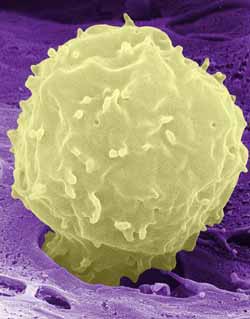White blood cells mediate insulin resistance

This is a false-colored, scanning electron micrograph of a neutrophil.<br><br>Credit: UC San Diego School of Medicine<br>
Researchers at the University of California, San Diego School of Medicine say neutrophils, an abundant type of white blood cell typically tasked with attacking bacteria and other foreign invaders, also plays an unexpected role in mediating insulin resistance – the central characteristic of type 2 diabetes, which afflicts an estimated 26 million Americans.
The findings are published in the August 5, 2012 Advance Online Publication of Nature Medicine.
Neutrophils are the first immune cells to respond to tissue inflammation, and can promote chronic inflammation by summoning other white blood cells called macrophages. Chronic low-grade inflammation – common in adipose or fat tissue – is an important cause of systemic insulin resistance.
Using liver and fat cells from mice and humans and live mouse models, a team led by Jerrold M. Olefsky, MD, associate dean for scientific affairs at UC San Diego Health Sciences and professor of medicine, discovered that an enzyme secreted by neutrophils called neutrophil elastase (NE) impairs insulin signaling and boosts resistance. Conversely, deletion of NE in obese mice fed a high-fat diet improved insulin sensitivity.
“These results are largely unexpected,” said Da Young Oh, an assistant project scientist in Olefsky's lab and study co-author. “Although several immune cells have been established in the etiology of insulin resistance, the role of neutrophils in this process has remained unclear until now.”
Oh said neutrophils were considered to be “transient infiltrates,” temporary cells (average lifespan: 5 days) that were incapable of sustaining chronic, low-grade inflammation. “Our studies now suggest neutrophils possess powerful immune modulatory effects,” Oh said.
Specifically, neutrophils use NE to activate a signaling pathway which triggers pathogen-eating macrophages to secrete proinflammatory molecules called cytokines. NE degrades IRS1, a key protein in the insulin signaling pathway in both liver and fat cells. Although NE has been shown to degrade this protein in lung cancer cells, the scientists said, the effect on insulin target tissues such as liver and adipose is striking.
The insulin-mediating role of neutrophils makes them a new target for developing treatments of insulin resistance in particular and diabetes in general. “Given that NE mediates insulin resistance, one could, in theory, take an NE activity inhibitory approach to reverse or improve insulin resistance,” Oh said, noting that NE inhibitors are already used for treatment of emphysema in Japan and are being tested in the United States, both for emphysema and type 1 diabetes.
Co-authors are Saswata Talukdar, Gautan Bandyopadhyay, Jianfeng Xu, Joanne McNelis, Min Lu, Pingping Li, Jachelle Ofrecio and Michael Lin, Department of Medicine, UCSD; Dongmei Li, Qingyun Yan, Yimin Zhu and Martin B. Brenner, Pfizer.
Funding for this research came, in part, from the National Institutes of Health (grants DK033651, DK074868, T32 DK007494, DK090962, and DK063491) and the Eunice Kennedy Shriver NICHD/NIH agreement (U54 HD 012303-25), part of the specialized Cooperative Centers Program in Reproduction and Infertility Research.
Media Contact
More Information:
http://www.ucsd.eduAll latest news from the category: Health and Medicine
This subject area encompasses research and studies in the field of human medicine.
Among the wide-ranging list of topics covered here are anesthesiology, anatomy, surgery, human genetics, hygiene and environmental medicine, internal medicine, neurology, pharmacology, physiology, urology and dental medicine.
Newest articles

Bringing bio-inspired robots to life
Nebraska researcher Eric Markvicka gets NSF CAREER Award to pursue manufacture of novel materials for soft robotics and stretchable electronics. Engineers are increasingly eager to develop robots that mimic the…

Bella moths use poison to attract mates
Scientists are closer to finding out how. Pyrrolizidine alkaloids are as bitter and toxic as they are hard to pronounce. They’re produced by several different types of plants and are…

AI tool creates ‘synthetic’ images of cells
…for enhanced microscopy analysis. Observing individual cells through microscopes can reveal a range of important cell biological phenomena that frequently play a role in human diseases, but the process of…





















